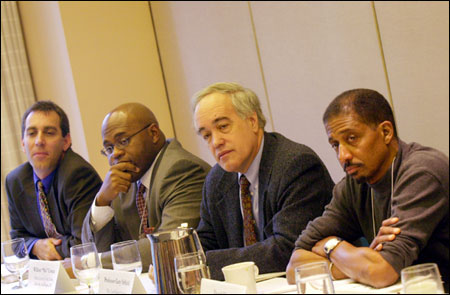Has Boston shed its racist reputation? :
Panel tackles racism and segregation in Boston

It’s been almost 30 years since buses of black students were pelted with rocks and tomatoes in South Boston. More than a decade has lapsed since Charles Stuart shot his wife in Mission Hill and sparked a veritable witch hunt for a black killer who never existed.
Is Boston, America’s third-whitest major metropolitan area, as racist as it once was? Can a city that embraces its history firmly and fondly shed its reputation? Is this city of neighborhoods in fact a city of segregated ethnic enclaves?
The Civil Rights Project at Harvard University joined Boston Magazine Wednesday (Oct. 30) to tackle racism and segregation in Boston in a panel discussion and public dialogue inspired by an article in the November 2002 Boston Magazine called “Divided We Stand.”
The panelists included Harvard professor and Civil Rights Project (CRP) co-founding director Gary Orfield; NAACP Boston president Leonard Alkins; Paul Watanabe, co-director of the Institute for Asian American Studies at the University of Massachusetts, Boston; and William “Mo” Cowan, partner in the Boston law firm Mintz, Levin Cohn, Ferris, Glovsky and Popeo, P.C., a co-sponsor of the event. They cast few backward glances to Boston’s racist past, engaging instead with the city’s still segregated present.
“This is a subject in Boston that doesn’t get talked about a lot. Usually when it does get talked about, it’s not in very polite terms,” said Doug Most, senior editor of Boston Magazine and author of the article. “It’s important that we try to jump-start a discussion on this.”
Boston is becoming a city of minorities, said Orfield, quoting statistics from several CRP studies. In the 1990s, he said, the white population of metro Boston fell by 1 percent while minority populations rose: blacks by 30 percent, Latinos by 47 percent, and Asians by 88 percent.
Looking to the future, he said, “we’re not going to have the same Boston, metrowide, that we’ve had.”
Politics and policy
Yet the city’s leadership remains predominantly white, with Irish and Italians filling political offices.
“If there’s one place you don’t see a lot of faces of color in Boston, it’s in politics,” said Most.
NAACP’s Alkins concurred. “Much of the problem centers around the lack of public policy and the willingness of people in positions to make those changes to even speak about them,” he said. “If you’re not willing to address the issue, you can never begin to resolve and … eradicate it.” he said.
While Mayor Thomas Menino and other leaders may lovingly describe Boston as a “city of neighborhoods,” David Harris, executive director of the Fair Housing Center of Greater Boston, cautioned that such enclaves can reinforce segregation and racism. “Neighborhood can be a code word for exclusion and exclusivity,” he said. “Too often, our reliance on neighborhood in fact has a way of keeping us apart.”
Across the river in Cambridge, Gary Orfield sees signs of hope in Harvard’s back yard. His Central Square neighborhood, he said, vibrates with ethnic diversity, integrated schools, successful businesses, and sought-after housing.
“There are some examples in metro Boston of places that have done these things very differently and very successfully. Why do we do them on such a small scale?” he said. “It’s important for us to take those positive things and think how we could bring them into Boston.”
While no one conclusively answered the question “Is Boston racist?,” panelists agreed that the city’s reputation remains scarred by its legacy of racism.
“The perception of the problem is the problem,” said Harris.
‘Friendly takeovers’
Harris, Cowan, and software developer Reggie Cummings, who organizes social networking events for blacks in Boston, said that they are unique among educated young black professionals: They’re still in Boston.
Cummings, a Boston native who left for college but returned, comes face-to-face with Boston’s ugly stereotype when he travels. “People ask me, ‘Why do you live in Boston? There are no black people in Boston. It’s the most racist place in the country,” he said.
Cummings organizes social events he calls “friendly takeovers,” inviting thousands of black professionals to join him in one of Boston’s many “fine bars and restaurants … that could use a little color.”
“Part of the problem is self-inflicted,” he said, noting that people of color can believe that the city’s rich offerings, from trendy clubs to Fenway Park to Symphony Hall, are not for them. “A lot of the change has to come from within.”
While Cummings’ events may seem like extreme measures, Cowan, charged with recruiting young lawyers to join his firm, asserts that the city’s “social desert” for people of color is a barrier to his efforts. Boston sees a brain drain of talented people of color who come to the city for an education then “get the hell outta Dodge,” he said.
As panelists looked forward to altering both the reality and perception of Boston as a city divided by race, they agreed that talk could spark change.
“One of the action steps we need to think about here, collectively, is how those of us who came here today keep this conversation going,” said Harris.




